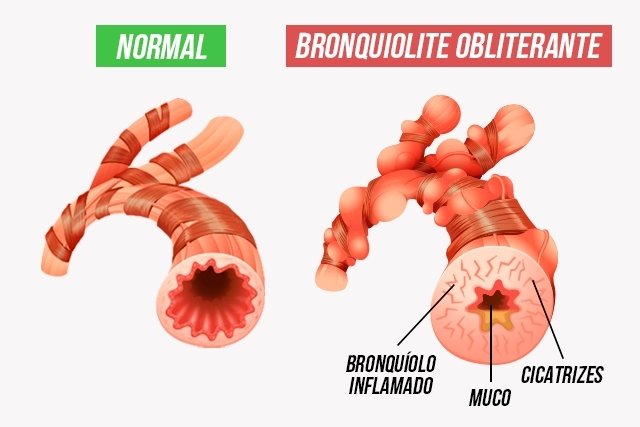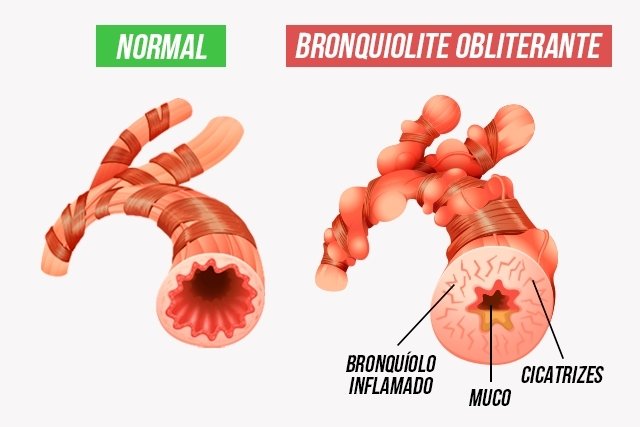Bronchiolitis obliterans is a type of chronic lung disease in which lung cells are unable to recover after inflammation or infection, causing obstruction of the airways and causing difficulty breathing, persistent coughing and a feeling of shortness of breath, for example.
In these cases, the inflamed lung cells, instead of being replaced by new cells, die and form a scar, which makes it difficult for air to pass through. Thus, if various inflammations appear in the lung over time, the number of scars increases and the small channels in the lung, known as bronchioles, are destroyed, making breathing difficult.
It is important that bronchiolitis obliterans is identified and treated according to the doctor’s recommendation, as this makes it possible to avoid complications and promote quality of life.

Symptoms of obliterative bronchitis
Most of the time, the initial symptoms of bronchiolitis obliterans are similar to any other lung problem, including:
- Wheezing when breathing;
- Feeling of shortness of breath and difficulty breathing;
- Persistent cough;
- Periods of low fever up to 38ºC;
- Tiredness;
- Difficulty feeding, in the case of infants.
These symptoms usually appear and disappear over several periods that can last for weeks or months.
Main causes
Bronchiolitis obliterans occurs when, due to some situation, there is an inflammatory reaction that results in an infiltrate in the bronchioles and alveoli, promoting irreversible obstruction of the airways. In most cases, this type of bronchitis is associated with infections, mainly caused by adenovirus. However, it can also happen as a consequence of infection with other types of viruses, such as the chickenpox or measles virus, or bacteria such as Mycoplasma pneumoniae, Legionella pneumophilia e Bordetella pertussis.
Although most cases are due to infection by microorganisms, bronchiolitis obliterans can also occur due to connective tissue diseases, as a result of inhalation of toxic substances or after bone marrow or lung transplantation.
How to confirm the diagnosis
The diagnosis of bronchiolitis obliterans must be made by a pediatric pulmonologist according to the signs and symptoms presented by the child, in addition to tests that help identify the cause of the bronchitis and its severity.
Therefore, the doctor may recommend performing a chest X-ray, computed tomography and lung scintigraphy, helping to differentiate bronchiolitis obliterans from other more common lung diseases. However, the definitive diagnosis can only be confirmed by lung biopsy.
How the treatment is carried out
The treatment aims to improve the child’s respiratory capacity and, to this end, the doctor may recommend the use of oral or inhaled anti-inflammatories and spray bronchodilators, which reduce inflammation in the lungs and reduce the amount of mucus, reducing the chances of emergence of new scars and facilitating the passage of air, in addition to oxygen therapy being recommended.
Respiratory physiotherapy may also be recommended with the aim of mobilizing and facilitating the elimination of secretions, preventing the occurrence of other respiratory infections. Understand how respiratory physiotherapy is performed.
If patients with bronchiolitis obliterans experience infections during the course of the disease, the doctor may recommend the use of antibiotics according to the infectious agent responsible for the attacks and exacerbations.

Sign up for our newsletter and stay up to date with exclusive news
that can transform your routine!
Warning: Undefined array key "title" in /home/storelat/public_html/wp-content/plugins/link-whisper-premium/templates/frontend/related-posts.php on line 12
Warning: Undefined array key "title_tag" in /home/storelat/public_html/wp-content/plugins/link-whisper-premium/templates/frontend/related-posts.php on line 13


![8 doenças que afetam mais as mulheres do que os homens [saúde]](https://storelatina.com/wp-content/uploads/2024/05/1716485840_8-diseases-that-affect-women-more-than-men-health-305x207.jpg)

